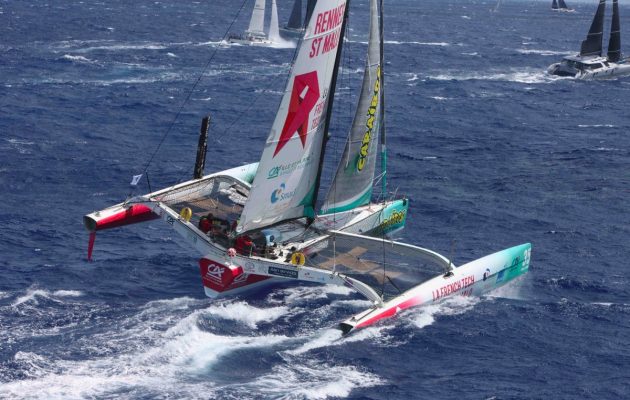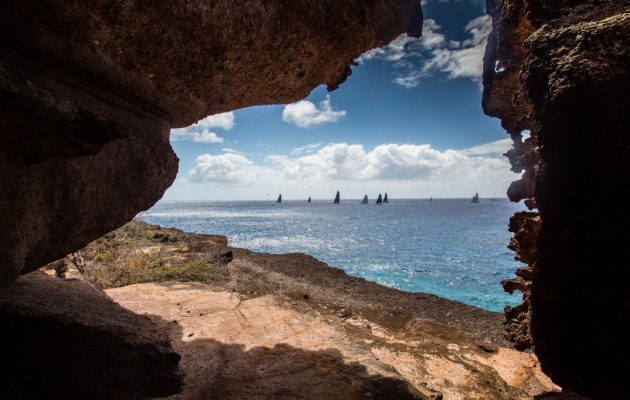A record entry of 84 yachts have got off to a flying start in the RORC Caribbean 600 race and could be on course for a record
A record fleet got off to a squally start from Antigua today in the RORC Caribbean 600 race. Some 84 starters, the largest number in the event’s ten-year history, crossed the line to punch their way up the first beat towards Barbuda in winds of 25-30 knots.
Strong northerly tradewinds mean that the multihull and monohull records of 39 and 40 hours respectively could be broken this year – and by diverse contenders, such as George David’s newly re-optimised Rambler 88 and the 42ft fully foiling F4 ‘missile’ catamaran being raced by America’s Cup sailor (and local) Shannon Falcone.
The course takes yachts on a tortuous 600-mile route around the islands of Barbuda, Nevis, Saba, St Barth, St Martin, Guadeloupe, Montserrat and back via Barbuda and Redonda, and features nearly every wind angle. This makes it a surprisingly tough and interesting event, something that has contributed to its steady growth, year on year.
Watch the race preview here>
The event was first suggested by former RORC marketing consultant John Burnie and Stan Pearson from Antigua Rigging and launched in 2008 after being taken up by the club’s CEO, Eddie Warden-Owen. It began with a small fleet of 24 yachts, and made a loss, but the club with it.
(“It was suggested we should run it every other year,” Warden-Owen recalls, “and I remember our treasurer saying: ‘That’s great; it will take us twice as long to go broke!’”)
Word soon got out that the Caribbean 600 was a fun but tricky event and anything but the dawdle round the islands some might have assumed. Over the last decade, it has evolved into a genuine Blue Riband event.
Today it ranks with the Rolex Middle Sea Race and even the RORC’s own Fastnet Race as a must-do offshore event, arduous in its own special way, but also sunny…and in the Caribbean…and in February.

Compared with the other major 600-milers, this race is even more international, with entries from 27 countries, most of which have sailed thousands of miles to take part.
So today the RORC Caribbean 600 is firmly established, with a fleet that spans yachts as small as 30ft – the smallest is the open Seacart 30 – through a clutch of Class 40s and chartered production racers up to supermaxis such as Ludde Ingvall’s CQS, Maxi 72 Proteus, Rambler 88 and a handful of superyachts such as Southern Wind SW102 Farfalla.
[UPDATE 2210UTC – CQS has retired following an electronic or software problem that caused the engine, which powers the hydraulic systems, to shut down.]
The crew lists glitter with top pros: America’s Cup sailors such as Brad Butterworth and Stu Bannatyne, Volvo and Vendée racers like Guillermo Altadill, US Olympic Gold medallist Jonathan McKee, plus a score of top navigators.
They enjoy it because this race can be a real challenge. Last year on Proteus, Stu Bannatyne tells me, they made “over 70 sail changes”. In a race lasting under two days, that’s a change on average every 45 minutes.

Fleet measurer Sandy Mair has done the race four times. “It’s a tough, tough race,” he tells me.
“You have legs that are 70 miles hard on the wind, brutal beats where the race can be won or lost, fast spinnaker runs, you’ve got 12 hours in the beating sun and 12 hours of darkness where, because you’re wet, you get cold. You feel really beaten up at the end,” he says, smiling as he says it.
Pro sailor and navigator Wouter Verbraak agrees. He is not sailing this year thanks to a skiing injury but recalls it as “very intense”. It is, he says, “a race all about gear changes. It’s a big job for the navigators to anticipate them. It is a really a great all-round challenge for crews, from driving to trimming to your bow team.
“It is hard because of the lack of opportunity for recovery and it’s really difficult to run a proper watch system. So you don’t get into a rhythm and it can be hard to manage the energy of your crew.
“You will have squalls in the morning and in the late afternoon, so you can end up damp and cold. It’s a bite-sized race, with bite-sized chunks of misery,” he says, laughing uproariously.
“But,” he adds, “it’s always just another 60 miles to the next point. There are a lot of corners, so there are a lot of opportunities. It’s intense but the weather is pleasant, there’s a lot of variety – and it’s scenic.”
The Caribbean 600 provides some fantastic challenges for navigators and, along with all the high-tech tools, features some good, old-fashioned Mk 1 eyeball skills and tactical challenges.

Weaving in and round squalls, and working out visually which might have wind, and on which sides, and which will be sucking out wind, is vital. So is working out how to avoid the wind shadows round some of the higher islands – and even working out where these might extend to if you arrive there in darkness.
“There are a lot of theories for day and night that you can break your head on,” says Verbraak.
All of which makes this race a special one for competitors, and for many an ideal introduction to serious offshore racing – all achievable in a week or ten days away from the office.
There is a great wrap-up video here:
There are also photos, on board videos and skipper interviews from the race on the Yachting World Facebook page.




